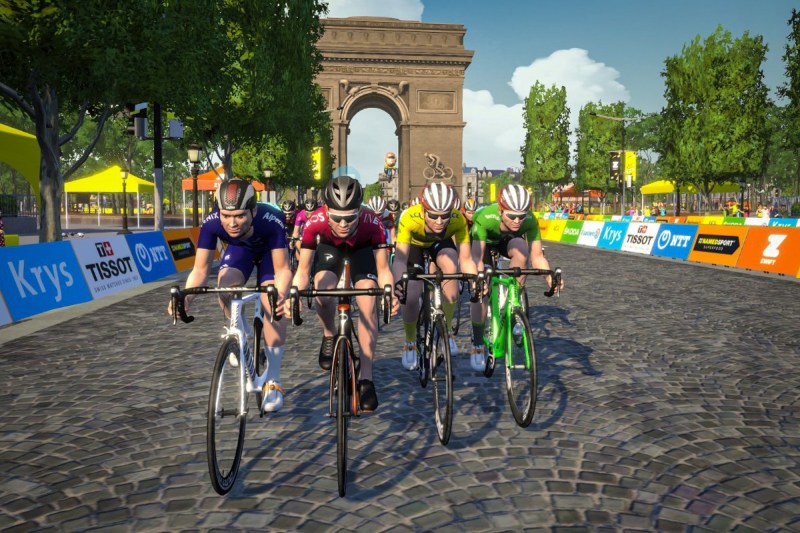In the 2020 Tour de Zwift, riders had the opportunity to unlock a spot in a virtual Tour de France, the ultimate cycling event, right from home.
The Tour de Zwift, appropriately, occurred on Zwift, a massively popular multiplayer online cycling and running physical training program that enables users to interact, train, and compete in a virtual world. Not only does the app attract at-home cyclists with road bikes and trainers linked to the Zwift system, but over 100,000 people also watched the 2022 UCI Cycling Esports World Championships, hosted by Zwift on February 26. (Union Cycliste Internationale is the world governing body for sports cycling and oversees international competitive cycling events.) As people from New York City to the Netherlands cheered virtual riders on, Zwift’s palpable ambition was on display. Not only does the company want to remain a global esports and gaming leader, but it also wants to bring digital cycling races onto the same vaunted level as real-life events, elevating the spinning sport for all.

February’s world championships, for example, attracted professionals like South African road cyclist Ashleigh Moolman Pasio, who competed in the last three Summer Olympics and won the first Zwift women’s world championship in 2020. The app is even building its own professionals who star on the platform.
Jay Vine went from Australian mountain biker to second-place finish on the Queen Stage on the Tour of Turkey for the Belgian UCI ProTeam Alpecin-Fenix team via Zwift. Vine earned his professional sponsorship through the Zwift Academy competition, a week-long reality-show-like elimination challenge through Zwift’s e-world, Watopia. Kyle Smyth from InGoodTaste PR (a Zwift representative) says this success is all due to the bonds forged between Zwift users.
“Zwift is a catalyst for the recreational rider as well as for athletes. It is the community that is leading the success of Zwift,” Smyth said. “They really live up to the Zwift tagline, ‘Ride On.’ Someone who is struggling or someone who is flying by you can signal to them with a wave, or draft on them so you’re exerting less effort.”
Founded in 2014, Zwift had 3.3 million registered accounts from 190 countries as of February 2021, double what it was the year before. The Zwift system flaunts two distinct advantages: Its at-home accessibility and collaborative platform elevated by ever-improving at-home riding setups.
“I’m a father of two littles now, so I don’t have access to just go out in the morning or evening when we have to get them to bed,” Smyth said. “It’s eye-opening for my schedule to [wake up before them] and go on rides at 5 a.m. or escape to the office in the evening after putting them to bed.”
Zwift riders also avoid mechanical issues like flat tires and weather complications like rain, snow, or too much heat when they’re able to work out in “pain caves” right from home. Road bikes, typically (although mountain bikes work as well) attach back tires to trainers — stationary gear systems that allow riders to pedal in place — which link into the Zwift system. Emerging accessories imitate more real-life conditions to take indoor cycling to the next level. Climbing forks, for instance, can attach to the front of bikes to move up and down on bumps or hills. There are available platforms for bikes to sit on for more of the side-to-side feel of riding.
Zwift gives riders thousands of options from four major Watopia maps, personalized structured workouts, training plans, and data-driven records. Rides can be solo jaunts or scheduled rides with other online riders. Gaming aspects like badge hunts and over 110,000 events get the competitive juices flowing.
“The scariness of racing for someone who’s never done it is pretty much alleviated,” Smyth said. “You can do an FTP (functional threshold point) test in Zwift and it will tell you the category that you should be riding in.”
Celebrities are on board, too, with over 700 professional athletes participating in Zwift events in the past year. Last week, for instance, players had the opportunity to go on a ride with former multisport superstar Bo Jackson.
Trainers run from a few hundred dollars to around $1,200 for elite setups. Zwift is still focusing on the app, but is slowly moving into more hardware. They now sell smart bikes for around $3,000.
Zwift means this esport to complement real-world cycling instead of serving as an alternative. Now a sponsor of the real-life Tour de France Femmes, the esports firm is pushing to equalize pay between men and women.
“It’s a real moment in cycling, not just an afterthought,” Smyth said. “With more people on more bikes more often, everyone wins. We want you to ride, and this will likely lead you to use something like Zwift.”



